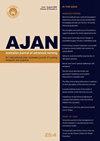Nurses documentation of falls prevention in a patient centred care plan in a medical ward
IF 1.3
4区 医学
Q3 NURSING
引用次数: 1
Abstract
Objective: To evaluate the consistency of nurses' documentation in the falls prevention assessment tool, and to ascertain whether patients identified as high risk of falling had falls preventative strategies implemented. Background: Falls are one of the leading causes of adverse events for patients in the hospital setting. The current practice of implementing falls prevention strategies for patients has not been able to be sustained, which remains a challenge for healthcare providers. Among the falls prevention strategies, falls risk assessment tools have been identified as a crucial element in falls prevention so as the number of falls are minimised. Study design and methods: Descriptive Cohort design, with the auditing of falls assessment documentation on the Patient Centred Care Plan. Results: The Patient Centred Care Plan audit revealed that 60.8% of patients (n=508) were identified as high risk of falls by the principal investigator. For the cohort of patients identified as by the nurses as having a high risk of falling (53.4%), 53.7% of patients had falls prevention strategies implemented, and only 17.5% of patients were engaged with their falls prevention plan. The strategies that were documented by the nurses on the care plan for the high-risk cohort were not implemented for 16.8% of the patients, and 29.5% of high risk of falls patients did not have documentation on the plan indicating their falls status. Discussion: The findings show that there is a significant gap in the identification of high falls risk patients and the documentation and implementation of falls prevention strategies, between nursing staff records on the Patient Centred Care Plan and the audit conducted by the principal investigator for patients who are identified as high falls risk. As part of the audit patient engagement in their falls prevention plan revealed that patients were not informed of their falls risk status by the nursing staff. Conclusion: The outcome from this audit signifies that not all high falls risk patients were identified as a high falls risk, and most of the high falls risk patients were not engaged in their falls prevention plan. Implications for research, policy and practice: Understanding the current practices of falls prevention and raising nursing staff awareness of the identified variance in the implementation of falls prevention strategies will improve the quality, efficiency of healthcare and the patient safety.护士在病房以病人为中心的护理计划中预防跌倒的记录
目的:评估跌倒预防评估工具中护士记录的一致性,并确定被确定为跌倒高风险的患者是否实施了跌倒预防策略。背景:跌倒是医院患者不良事件的主要原因之一。目前对患者实施跌倒预防策略的做法无法持续,这仍然是医疗保健提供者面临的挑战。在预防跌倒的策略中,跌倒风险评估工具已被确定为预防跌倒的关键因素,以尽量减少跌倒的次数。研究设计和方法:描述性队列设计,对以患者为中心的护理计划的跌倒评估文件进行审核。结果:以患者为中心的护理计划审计显示,60.8%的患者(n=508)被主要研究者确定为高风险跌倒。在护士确定为跌倒高危人群(53.4%)的队列中,53.7%的患者实施了跌倒预防策略,只有17.5%的患者参与了跌倒预防计划。16.8%的患者没有执行护士在高危队列护理计划中记录的策略,29.5%的高风险跌倒患者没有在计划中记录他们的跌倒状态。讨论:研究结果表明,在识别高跌倒风险患者以及记录和实施跌倒预防策略方面,护理人员在以患者为中心的护理计划上的记录与主要研究者对确定为高跌倒风险患者的审计之间存在重大差距。作为审计的一部分,患者参与他们的跌倒预防计划显示,患者没有被告知他们的跌倒风险状态的护理人员。结论:本次审计的结果表明,并不是所有的高跌倒风险患者都被确定为高跌倒风险,大多数高跌倒风险患者没有参与他们的跌倒预防计划。对研究、政策和实践的启示:了解目前预防跌倒的做法,提高护理人员对预防跌倒策略实施中确定的差异的认识,将提高医疗保健的质量、效率和患者安全。
本文章由计算机程序翻译,如有差异,请以英文原文为准。
求助全文
约1分钟内获得全文
求助全文
来源期刊
CiteScore
2.30
自引率
7.10%
发文量
27
审稿时长
>12 weeks
期刊介绍:
The Australian Journal of Advanced Nursing publishes a wide variety of original research, review articles, practice guidelines, and commentary relevant to nursing and midwifery practice, health- maternity- and aged- care delivery, public health, healthcare policy and funding, nursing and midwifery education, regulation, management, economics, ethics, and research methodology. Further, the journal publishes personal narratives that convey the art and spirit of nursing and midwifery.
As the official peer-reviewed journal of the ANMF, AJAN is dedicated to publishing and showcasing scholarly material of principal relevance to national nursing and midwifery professional, clinical, research, education, management, and policy audiences. Beyond AJAN’s primarily national focus, manuscripts with regional and international scope are also welcome where their contribution to knowledge and debate on key issues for nursing, midwifery, and healthcare more broadly are significant.

 求助内容:
求助内容: 应助结果提醒方式:
应助结果提醒方式:


